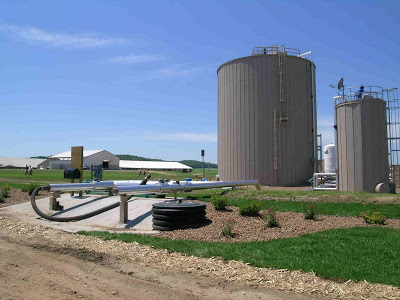by jboullion | Jan 30, 2009 | Uncategorized
The Wisconsin Renewable Quarterly, RENEW Wisconsin’s newsletter, features these articles:
+ Rest in Peace: Cassville Generation Plant
+ Mississippi River Bird and Bat Study
+ Osceola School Heats Pools with Solar
+ Bob Ramlow: Solar Pioneer
+ Focus on Energy Issues Biogas Profiles
+ Focus on Energy Earns National Honor
+ State Plugs into Renewable Energy
by jboullion | Jan 30, 2009 | Uncategorized
The Wisconsin Renewable Quarterly, RENEW Wisconsin’s newsletter, features these articles:
+ Rest in Peace: Cassville Generation Plant
+ Mississippi River Bird and Bat Study
+ Osceola School Heats Pools with Solar
+ Bob Ramlow: Solar Pioneer
+ Focus on Energy Issues Biogas Profiles
+ Focus on Energy Earns National Honor
+ State Plugs into Renewable Energy

by jboullion | Jan 7, 2009 | Uncategorized
 The larger of the two tanks digests the manure at the Five Star Dairy near Eau Claire. Photo by Ed Blume, RENEW Wisconsin
The larger of the two tanks digests the manure at the Five Star Dairy near Eau Claire. Photo by Ed Blume, RENEW Wisconsin
From an article in the Daily Pioneer (Platteville):
PLATTEVILLE – Tim Zauche, associate professor of chemistry and engineering physics at the University of Wisconsin-Platteville, wants manure from area dairy farms. But he just wants to borrow it.
Zauche and Christopher Baxter, UWP associate professor of agriculture, met with about 25 Grant and Lafayette county dairy farmers on Monday, Jan. 5, to discuss the feasibility of building an anaerobic digester in the region. The digester would collect methane gas from cow manure. The methane could be converted into a variety of useable energy sources.
“The university is interested in anaerobic digesters because we’re striving to become more sustainable,” Zauche said. “We’re looking to become more independent of our energy needs from other places.”
The project is just in the exploratory stage. Details of the project – including who would own the digester, where it would be located, what would be expected of participating farmers and a number of more technical details – need to be worked out, Zauche said.
Zauche said that the digester would need to process manure from at least 500 cows to be economically feasible. That could be reduced somewhat if the digester also processes production waste from several area cheese factories. Baxter said that the UWP Pioneer Farm plans to increase its herd to 300 cows, which includes dairy cows and a planned expansion of its beef herd.
by jboullion | Jan 2, 2009 | Uncategorized
A column by Mike Nichols in the Milwaukee Journal Sentinel seems to present an either/or dicotomy between wind-generated electricity and digester-generated electricity. Nichols wrote:
This is something to ponder as we head into a new year – and a new era. We are developing huge wind farms in Wisconsin. People are talking about setting turbines out on our Great Lakes. Breaking wind could be the key to the future. The only question now is “What kind?”
Do we harness our skies or our pies?
The Journal Sentinel published the following response from RENEW’s executive director Michael Vickerman:
The statement that Wisconsin can generate more electricity from manure than from windpower is not supported by the numbers.
To make biogas from manure, a dairy farm operator has to keep the cows inside and under a roof at all times. Only in a confined setting is it possible to collect cow manure and break it down in an oxygen-free digester that results in methane. Of Wisconsin’s 1.3 million dairy cows, only one-eighth of them live in confined animal operations. The average dairy cow here is part of a small herd and spends a considerable amount of time in pasture.
As stated in the column, Wisconsin is well ahead of other states in capturing energy from dairy cow manure and generating electricity with it, and there is certainly room for growth. Bear in mind, however, that takes more than 2,000 dairy cows to produce enough methane to equal the output from one commercial wind turbine. Yes, Wisconsin now boasts about two dozen biogas generation systems attached to dairy farms. But compared with the output from the 251 wind turbines installed this year at four different projects, their electrical production is quite modest.
Though other locally available resources–solar, small hydro, woody fuels and biomethane—will certainly play a larger part in contributing to Wisconsin’s electricity mix, wind energy will remain the renewable energy workhorse for the foreseeable future.
Finally, the Governor’s Global Warming Task Force recommended a raft of policies to achieve a renewable energy goal of 25% by 2025, no small undertaking I can assure you. If we are serious about achieving that goal, we must accept expanded contributions from all eligible resources. We do not have the luxury of playing favorites.
by jboullion | Dec 29, 2008 | Uncategorized
From the announcement of the Manure Digester Summit:
Whether you have less than a 100-head herd or a large herd, digesters can work for you. Come to the seminar to hear how Dane County and Richland County are using community digesters as well as how to implement a manure digester on a 50-head farm.
Tuesday, January 13, 2009
9:30AM -3:00PM
Room B-30 West Square Building
505 Broadway
Baraboo, Wisconsin
Cost: $20.00 and includes lunch

